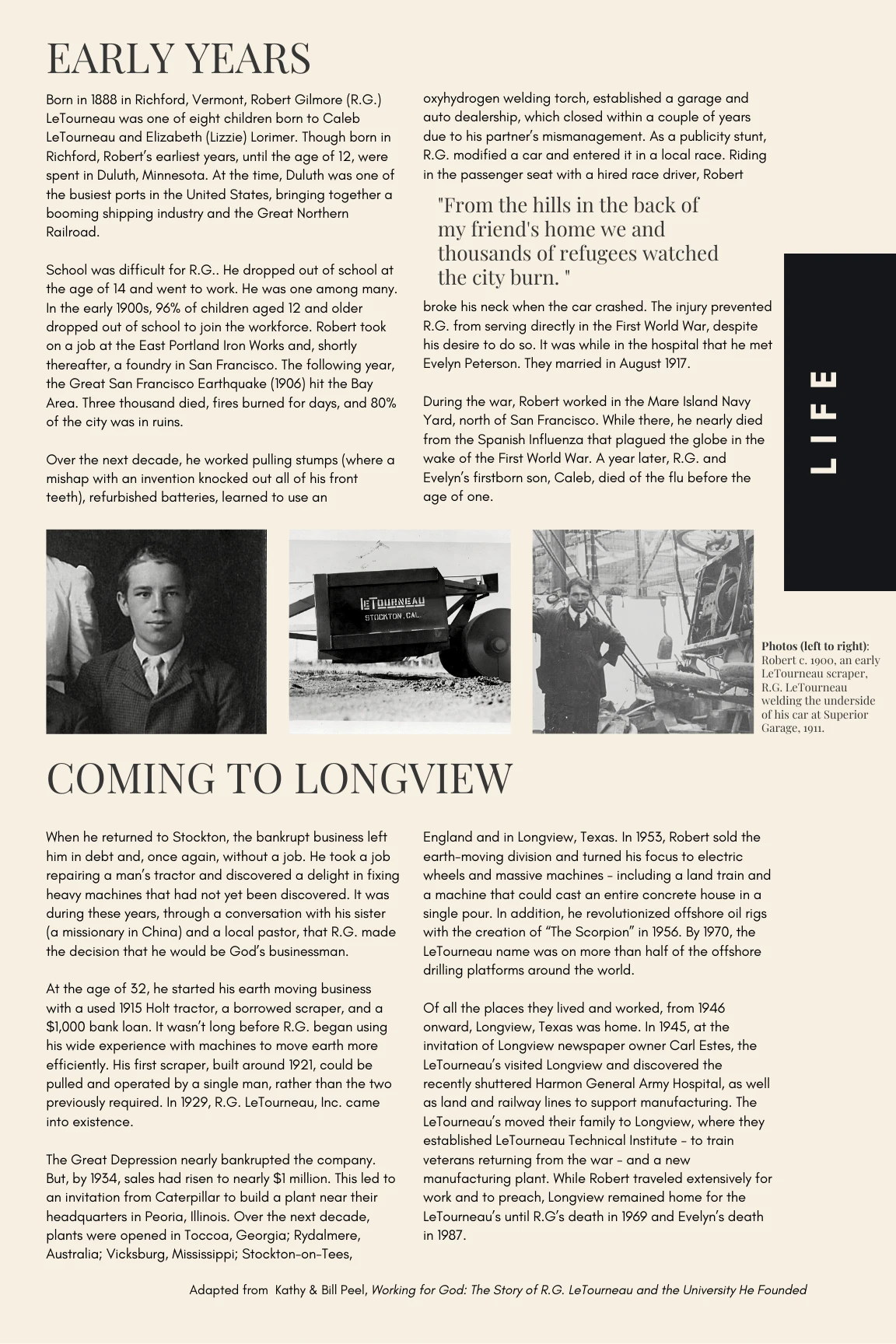Early Years
Born in 1888 in Richford, Vermont, Robert Gilmore (R.G.) LeTourneau was one of eight children born to Caleb LeTourneau and Elizabeth (Lizzie) Lorimer. Though born in Richford, Robert’s earliest years, until the age of 12, were spent in Duluth, Minnesota. At the time, Duluth was one of the busiest ports in the United States, bringing together a booming shipping industry and the Great Northern Railroad.
School was difficult for R.G.. He dropped out of school at the age of 14 and went to work. He was one among many. In the early 1900s, 96% of children aged 12 and older dropped out of school to join the workforce. Robert took on a job at the East Portland Iron Works and, shortly thereafter, a foundry in San Francisco. The following year, the Great San Francisco Earthquake (1906) hit the Bay Area. Three thousand died, fires burned for days, and 80% of the city was in ruins.
Over the next decade, he worked pulling stumps (where a mishap with an invention knocked out all of his front teeth), refurbished batteries, learned to use an oxyhydrogen welding torch, established a garage and auto dealership, which closed within a couple of years due to his partner’s mismanagement. As a publicity stunt, R.G. modified a car and entered it in a local race. Riding in the passenger seat with a hired race driver, Robert broke his neck when the car crashed. The injury prevented R.G. from serving directly in the First World War, despite his desire to do so. It was while in the hospital that he met Evelyn Peterson. They married in August 1917.
During the war, Robert worked in the Mare Island Navy Yard, north of San Francisco. While there, he nearly died from the Spanish Influenza that plagued the globe in the wake of the First World War. A year later, R.G. and Evelyn’s firstborn son, Caleb, died of the flu before the age of one.
LeTourneau & Longview
When he returned to Stockton, the bankrupt business left him in debt and, once again, without a job. He took a job repairing a man’s tractor and discovered a delight in fixing heavy machines that had not yet been discovered. It was during these years, through a conversation with his sister (a missionary in China) and a local pastor, that R.G. made the decision that he would be God’s businessman.
At the age of 32, he started his earth moving business with a used 1915 Holt tractor, a borrowed scraper, and a $1,000 bank loan. It wasn’t long before R.G. began using his wide experience with machines to move earth more efficiently. His first scraper, built around 1921, could be pulled and operated by a single man, rather than the two previously required. In 1929, R.G. LeTourneau, Inc. came into existence.
The Great Depression nearly bankrupted the company. But, by 1934, sales had risen to nearly $1 million. This led to an invitation from Caterpillar to build a plant near their headquarters in Peoria, Illinois. Over the next decade, plants were opened in Toccoa, Georgia; Rydalmere, Australia; Vicksburg, Mississippi; Stockton-on-Tees, England and in Longview, Texas. In 1953, Robert sold the earth-moving division and turned his focus to electric wheels and massive machines - including a land train and a machine that could cast an entire concrete house in a single pour. In addition, he revolutionized offshore oil rigs with the creation of “The Scorpion” in 1956. By 1970, the LeTourneau name was on more than half of the offshore drilling platforms around the world.
Of all the places they lived and worked, from 1946 onward, Longview, Texas was home. In 1945, at the invitation of Longview newspaper owner Carl Estes, the LeTourneau’s visited Longview and discovered the recently shuttered Harmon General Army Hospital, as well as land and railway lines to support manufacturing. The LeTourneau’s moved their family to Longview, where they established LeTourneau Technical Institute - to train veterans returning from the war - and a new manufacturing plant. While Robert traveled extensively for work and to preach, Longview remained home for the LeTourneau’s until R.G’s death in 1969 and Evelyn’s death in 1987.
(Adapted from Kathy & Bill Peel, Working for God: The Story of R.G. LeTourneau and the University He Founded.)
